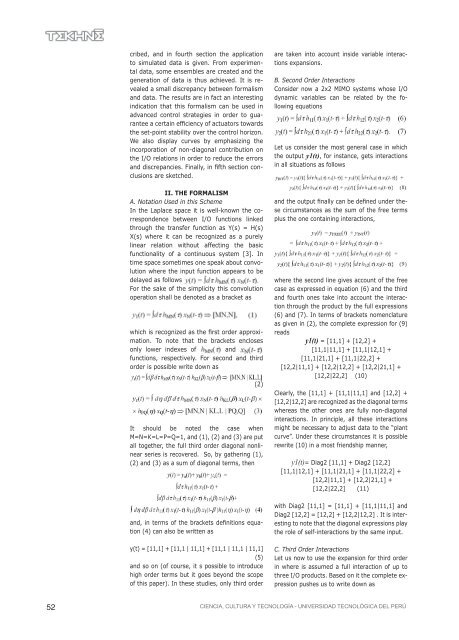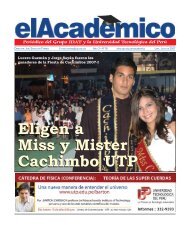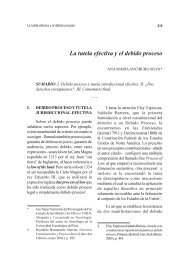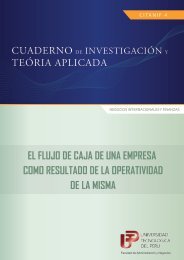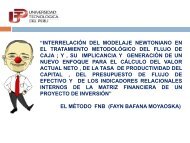Descargar - UTP
Descargar - UTP
Descargar - UTP
Create successful ePaper yourself
Turn your PDF publications into a flip-book with our unique Google optimized e-Paper software.
52<br />
cribed, and in fourth section the application<br />
to simulated data is given. From experimental<br />
data, some ensembles are created and the<br />
generation of data is thus achieved. It is revealed<br />
a small discrepancy between formalism<br />
and data. The results are in fact an interesting<br />
indication that this formalism can be used in<br />
advanced control strategies in order to guarantee<br />
a certain efficiency of actuators towards<br />
the set-point stability over the control horizon.<br />
We also display curves by emphasizing the<br />
incorporation of non-diagonal contribution on<br />
the I/O relations in order to reduce the errors<br />
and discrepancies. Finally, in fifth section conclusions<br />
are sketched.<br />
II. THE FORMALISM<br />
A. Notation Used in this Scheme<br />
In the Laplace space it is well-known the correspondence<br />
between I/O functions linked<br />
through the transfer function as Y(s) = H(s)<br />
X(s) where it can be recognized as a purely<br />
linear relation without affecting the basic<br />
functionality of a continuous system [3]. In<br />
time space sometimes one speak about convolution<br />
where the input function appears to be<br />
delayed as follows<br />
For the sake of the simplicity this convolution<br />
operation shall be denoted as a bracket as<br />
which is recognized as the first order approximation.<br />
To note that the brackets encloses<br />
only lower indexes of and<br />
functions, respectively. For second and third<br />
order is possible write down as<br />
(2)<br />
It should be noted the case when<br />
M=N=K=L=P=Q=1, and (1), (2) and (3) are put<br />
all together, the full third order diagonal nonlinear<br />
series is recovered. So, by gathering (1),<br />
(2) and (3) as a sum of diagonal terms, then<br />
and, in terms of the brackets definitions equation<br />
(4) can also be written as<br />
y(t) = [11,1] + [11,1 | 11,1] + [11,1 | 11,1 | 11,1]<br />
(5)<br />
and so on (of course, it s possible to introduce<br />
high order terms but it goes beyond the scope<br />
of this paper). In these studies, only third order<br />
are taken into account inside variable interactions<br />
expansions.<br />
B. Second Order Interactions<br />
Consider now a 2x2 MIMO systems whose I/O<br />
dynamic variables can be related by the following<br />
equations<br />
Let us consider the most general case in which<br />
the output y1(t), for instance, gets interactions<br />
in all situations as follows<br />
and the output finally can be defined under these<br />
circumstances as the sum of the free terms<br />
plus the one containing interactions,<br />
where the second line gives account of the free<br />
case as expressed in equation (6) and the third<br />
and fourth ones take into account the interaction<br />
through the product by the full expressions<br />
(6) and (7). In terms of brackets nomenclature<br />
as given in (2), the complete expression for (9)<br />
reads<br />
y1(t) = [11,1] + [12,2] +<br />
[11,1|11,1] + [11,1|12,1] +<br />
[11,1|21,1] + [11,1|22,2] +<br />
[12,2|11,1] + [12,2|12,2] + [12,2|21,1] +<br />
[12,2|22,2] (10)<br />
Clearly, the [11,1] + [11,1|11,1] and [12,2] +<br />
[12,2|12,2] are recognized as the diagonal terms<br />
whereas the other ones are fully non-diagonal<br />
interactions. In principle, all these interactions<br />
might be necessary to adjust data to the “plant<br />
curve”. Under these circumstances it is possible<br />
rewrite (10) in a most friendship manner,<br />
y1(t)= Diag2 [11,1] + Diag2 [12,2]<br />
[11,1|12,1] + [11,1|21,1] + [11,1|22,2] +<br />
[12,2|11,1] + [12,2|21,1] +<br />
[12,2|22,2] (11)<br />
with Diag2 [11,1] = [11,1] + [11,1|11,1] and<br />
Diag2 [12,2] = [12,2] + [12,2|12,2] . It is interesting<br />
to note that the diagonal expressions play<br />
the role of self-interactions by the same input.<br />
C. Third Order Interactions<br />
Let us now to use the expansion for third order<br />
in where is assumed a full interaction of up to<br />
three I/O products. Based on it the complete expression<br />
pushes us to write down as<br />
CIENCIA, CULTURA Y TECNOLOGÍA - UNIVERSIDAD TECNOLÓGICA DEL PERÚ


